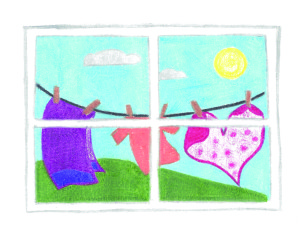I finally handed off the manuscript for my first book to the publisher. To celebrate, I am posting a short excerpt here on TIGA. I wrote this book for my daughter, Lindsay, in celebration of her graduation from high school. It’s called The Laundry List: All the things I forgot to tell you about laundry and life. The illustrations are by a talented local high school student, Keesha Freskiw. This piece is called First Principles: A few ideas to smooth the wrinkles in your laundry path.

Laundry is one of those things in life that, done well, can be a great comfort, a foundation thread that holds everything together. Done poorly or not at all, it can be a persistent source of irritation. There’s a lot to be said for a crisp white shirt hanging in your closet, clean and ready to wear when you need it, or fresh sheets welcoming you into bed at night, especially if they were hung to dry in a summer breeze. Okay, I admit that I have never hung sheets to dry in a summer breeze, but we can dream, can we not?
With that in mind, here’s a quick list of basic principles for you to consider as you set out on your own laundry path:
1. Keep the end in mind. Your mission, should you choose to accept it, is to keep your clothing, towels and bed linens in good condition and to neatly restore them to their respective closets or drawers once laundered. Perhaps that sounds obvious, but keep in mind that laundry starts long before you open the lid of the washing machine.
2. Embrace reasonable standards. When I was a teenager, I had a friend whose European mom ironed all her t-shirts and, allegedly, all of her father’s underwear. Now, it is not for me to judge someone else’s laundry or lifestyle choices, but for my part, I can think of happier, more productive ways to spend my time than ironing an article of clothing that will become wrinkled within 15 minutes of my pulling it over my head. Find a reasonable middle ground. (Of course, if ironing is your meditation, then that is something else entirely).
3. Don’t create more work for yourself than necessary. Dropping your just-worn clothes on the floor as you undress may seem like a quick-and-easy approach to laundry management, but is it really? No. It’s a deferred decision to that all important question – will I wear those pants again or do they need to be washed? – and the longer you leave them, the more linty, crumply, and unwearable they will become. So, take a moment to put things where they belong – either in the laundry basket or back on the hanger – and spare yourself more work later.
4. An ounce of prevention is worth a pound of stain remover. One day, as Sarah and I drove along Highway 12, she caught sight of a car in her rear-view that was following us much too closely. “In Driver’s Ed, they teach us that car accidents don’t just happen,” she said, lightly touching the brakes to back off the tail-gater. “They develop.” The same is true for stains. So take a few preventative measures: wear an apron when you’re cooking, especially if tomatoes, or red wine are involved. If you need to check the oil in your car, don’t do it while wearing your favourite blouse. Designate old clothes for garden work, painting and other clothing-hazardous jobs.
5. Time is not on your side where stains are concerned so act accordingly. The longer that tea stain steeps on the hem of your white peasant blouse, the tougher it will be to remove later. Stains happen. Deal with them. Double-quick.
* * * * * *
I’ll post Part 2 next week. Namaste, and happy laundering to all.
Illustration courtesy of K. Freskiw (c) 2015